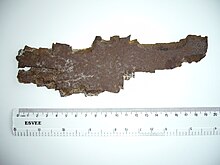Splinters (ammunition)

Splinters are pieces of ammunition that are thrown away in a detonation and are intended to have an effect.
One differentiates:
- shaped splinters like in the German jumping mine
Common splinter shapes are spheres, cuboids, rods, arrows and staples. The screws or nails often used in IEDs can be added to the rods.
- controlled fragments , such as the shell of the submunition of cluster bombs . The circular blanks of the deep-drawn bomb bodies are shaped like a waffle before being drawn. After the finished bomb baskets have hardened, the embossing serves as a predetermined breaking point and fragments of defined dimensions are created when detonated.
Common methods of influencing the fragmentation effect are internal or external grooves in the casing or grooves in the explosive device within the casing.
- natural splinters like the Mills grenade , the noticeable notches of which have little influence on the splinter formation.
The splinters consist mainly of metal ; the effective parameters are the mass and the speed. However, there are also ammunition whose active body is made of plastic . The relatively light plastic actually contradicts the physical requirements for an optimal splitter. The purpose of these splinters is to make treatment of a victim hit by splinters more difficult. Plastic fragments are much more difficult to see on X-rays than metal fragments . After GI were increasingly wounded by the nylon balls of their own hand grenades and Claymore mines during the Vietnam War , the development of magnetic resonance imaging was accelerated . On October 10, 1980, the Convention on the Prohibition or Restriction of the Use of Certain Conventional Weapons , Which May Cause Excessive Suffering or May Work Indiscriminately, was signed in Geneva, which entered into force on December 2, 1983. Protocol I, which is part of this agreement, prohibits the use of weapons whose main effect is based on injuries caused by fragments that cannot be detected by X-rays.
Splinter characteristic

The fragment characteristics are determined by static explosive tests and describe the decomposition of the active body according to the number, shape and mass of the fragments.
Splinter density
The chip density is the number of effective chips per unit area depending on the distance. The performance characteristic of fragmentation ammunition is specified as the distance at which the fragment density 1, i.e. H. an effective splinter per square meter occurs. A splinter is effective when it penetrates a standardized target (usually steel or aluminum plates) in the splinter garden or creates a crack through which light falls.
Demarcation
In addition to the splinters, litter pieces are formed during the detonation:
- Explosives (parts of the ammunition, its packaging or the explosive object, with the exception of splinters),
- Debris (e.g. parts of buildings, trusses and facilities).
Individual evidence
- ^ "Central service regulation of the Bundeswehr - ZDv 30/41" Terms of logistics and armament "(as of April 2013).
Web links
- Report of the Federal Government on its export policy for conventional armaments in 2017 (accessed on April 30, 2020)
- Is the fragmentation behavior of the MJG predictable or predictable? (accessed April 30, 2020)
- Stunning effect of various rifle calibers (accessed April 30, 2020)
- Warfare with uranium bullets (accessed April 30, 2020)
